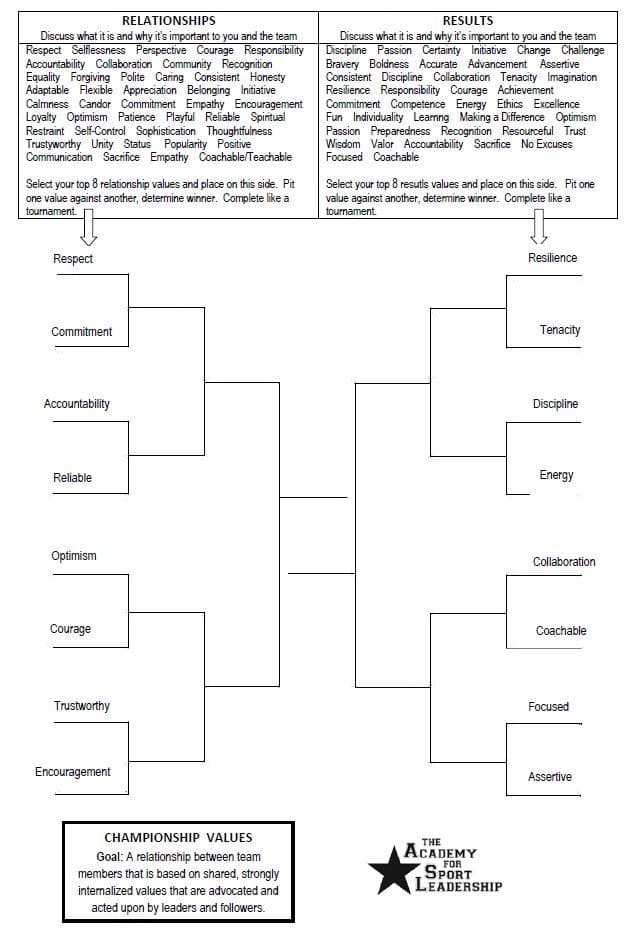Cory Dobbs, Ed.D.
Founder, The Academy for Sport Leadership
Championship Values
Values are among the most stable and enduring characteristics of people. They are the foundation on which attitudes and personal preferences are formed. Our core values are crucial in making vital decisions, determining life directions, and behaving in social interactions. Values help define our morality and our conceptions of what is “good” and what is “right.” Many of our behaviors are a product of the basic values we have developed throughout our lives.
However, a problem with values is that they are generally taken for granted. Most of the time people are unaware of their values and how they shape attitudes and behaviors. Unless a person’s value’s are challenged they will remain largely undetected. People are not aware that they hold some values as being more important than others. This unawareness leads to actions or behaviors that are sometimes contrary to values, or even leads to confusion about values.
The Championship Values exercise is an interactive tool for you to use in determining your values and those of your teammates. As you work through the eight steps to your team’s Championship Values, keep in mind that sometimes the best way to stimulate discussion of values is to pose a difficult situation that demands a hard look at how a value will help you best resolve the situation. For additional resources for value-driven leadership consider The Academy for Sport Leadership’s Case Studies.
Step 1 Each team member is to think through the values (Relationship Oriented and Results Oriented) and identify circle the sixteen (8 Relationship / 8 Results) most important values—for you as a member of this team. Be sure to carefully think through just what the value is and why it’s important to you.
Step 2 Fill in the brackets with your eight (8) Relationship Oriented values on the left side and eight (8) Results Oriented values on the right side. Do this exercise individually.
Step 3 Pitting value vs. value tournament style. After placing all sixteen values in the brackets,
determine a winner and move the winning values along toward the middle of the chart.
Step 4 Once you’ve completed your Championship Values tournament you’ll have identified your top four values (2 Relationship / 2 Results). Be sure that you’ve thought through the value of each
value!
Step 5 Now split your team into triads (groups of three) and discuss the values. As a triad come to an agreement on 16 values and fill out the brackets. This should take some time as you and your teammates will need to work through personal differences to reach shared values.
Step 6 Once you’ve got the 16 shared values begin your tournament. At each stage engage in
meaningful conversation to identify a winning value.
Step 7 Once you’ve completed your Championship Values tournament as a triad, begin the same process as a team. When you finish your tournament you will have identified four (the final four
values) values that will be strongly internalized, advocated, and acted upon by all team members. The discussion should reveal values a clear-cut set of values for you and your teammates—standards of behavior towards one another and individual and team performance.
Step 8 Do the Championship Values exercise as a complete team. Your goal is a relationship between team members based on shared, strongly internalized values that are advocated and acted
upon by all team members.
Click here to download a blank template of the Tool

To find out more about and order Sport Leadership Books authored by Dr. Dobbs including Coaching for Leadership, click this link: The Academy for Sport Leadership Books
About the Author
A former basketball coach, Cory’s coaching background includes experience at the NCAA DII, NJCAA, and high school levels of competition. While coaching, he researched and developed the transformative Becoming a Team Leader program for student-athletes. Cory has worked with professional athletes, collegiate athletic programs and high schools teaching leadership as a part of the sports experience and education process. Cory cut his teeth as a corporate leader with Fortune 500 member, The Dial Corp. As a consultant and trainer Dr. Dobbs has worked with such organizations as American Express, Honeywell, and Avnet.
Cory has taught a variety of courses on leadership and change for the following universities:
Northern Arizona University (Graduate Schools of Business and Education)
Ohio University (Graduate School of Education / Management and Leadership in Sport)
Grand Canyon University (Sports Marketing and Sports Management in the Colangelo School of Sports Business)
